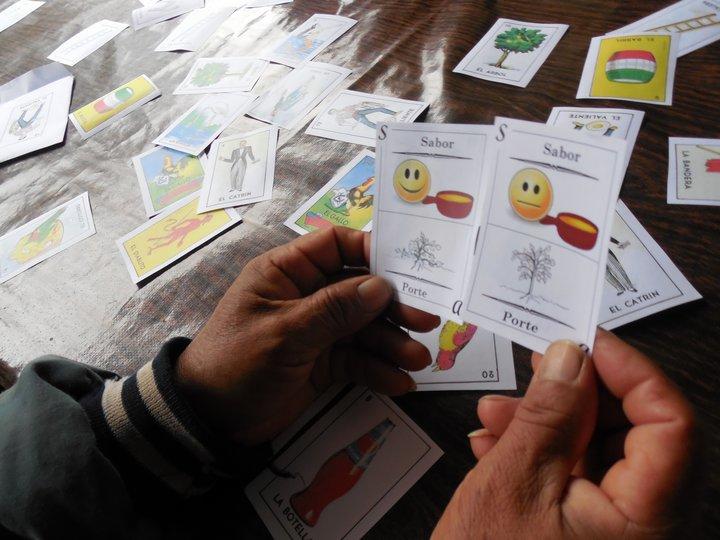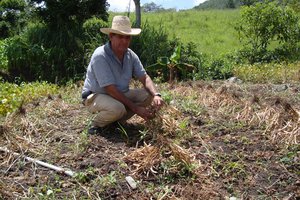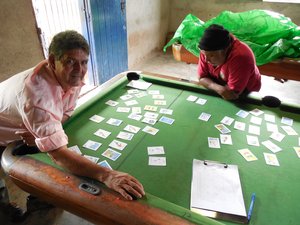Participatory research is a serious game

On a warm afternoon in a small farming village in Honduras, half a dozen farmers sit with a visitor from an NGO they’ve worked with before. They’re there to discuss the farmers’ priorities to improve their main crop, beans. What do the farmers need most? What should the bean breeders focus on?
On a warm afternoon in a small farming village in Honduras, half a dozen farmers sit with a visitor from an NGO they’ve worked with before. They’re there to discuss the farmers’ priorities to improve their main crop, beans. What do the farmers need most? What should the bean breeders focus on?
At this point, things could go one of several ways, most of them somewhat tedious, all requiring highly trained facilitators and highly motivated farmers. Instead, the NGO visitor announces, “Let’s play a game.”
He gives each farmer a pack of cards, and tells them to spread them out, face down, on the table before them. The farmers chuckle as they recognize the backs of the cards: colourful drawings of melons, hands, a mandolin, a drum.
“I know this game,” says one to her neighbour. “We’re going to play loteria.”
And so it goes. The NGO visitor calls out “melon”. Each farmer searches her deck for the two cards with a picture of a melon and turns them over. Now the “game” becomes more serious.
Each card has two pictures, a plant and a pile of beans. On one, the pile of beans is large and the plant has been ravaged by pests. On the other, the plant is less damaged, but the pile of beans is smaller.
“Which do you prefer,” asks the NGO visitor. “Don’t say anything. Just show me the card you prefer.”
There’s some thought, maybe some chit-chat, and eventually the farmers hold up their cards, facing the NGO visitor. On the score sheet, he marks each farmer’s preference, for yield, or pest resistance.
Less than an hour later, the farmers have gone through 21 hands of the game, each showing which of seven different bean traits they value more. Plugging the results into a software package, the NGO quickly has a ranking of their priorities, which, with the results from other representative villages, can go straight to the bean breeders to guide their work.
"Playing this game with the farmers tells us pretty well what changes they would like to see in their varieties of bean. This knowledge is crucial for breeders to develop new crosses and to enable local partners to identify existing varieties of bean that may better suit these farmers' aspirations," explains Jonathan Steinke, one of the researchers developing this gamification approach.
“The method is simpler, less expensive, and requires fewer resources to run,” continues Jacob van Etten, a research scientist at Bioversity International. “And when we compared it to one of the more formal methods that researchers use in participatory research, the results were essentially the same.”
Van Etten and Steinke describe their work to develop and test this new approach to priority setting in Gamification of farmer-participatory priority setting in plant breeding: Design and validation of “AgroDuos”, recently published in the Journal of Crop Improvement. It is just one element in Bioversity’s push to promote citizen science in the service of adaptation to climate change.
 The basic approach, known as tricot (for triadic comparisons of technologies), has proven its worth, helping farmers in Central America, East Africa and India to select better-performing crop varieties and at the same time providing researchers with valuable information about the crops and the traits that farmers judge most important.
The basic approach, known as tricot (for triadic comparisons of technologies), has proven its worth, helping farmers in Central America, East Africa and India to select better-performing crop varieties and at the same time providing researchers with valuable information about the crops and the traits that farmers judge most important.
However, fundamental questions remain: why do farmers participate? What motivates them? Answers, van Etten says, will help scientists to build even stronger collaborations with farmers, benefitting both groups.
In search of some answers, van Etten, together with Eskender Beza of Wageningen University and other colleagues, surveyed more than 425 farmer participants in Ethiopia, Honduras and India. They report on what motivates the farmers and how they use their mobile phones in a new paper in PLOS One.
Overall, farmers tend to fall into one of two distinct groups. Some are motivated by intrinsic factors such as sharing information, helping others and contributing to research. Others talk about their motivation more in terms of extrinsic factors, such as the expectation of a reward or interactions with experts and with their communities. Education accounted for some of the differences among groups; most notably, the Indian farmers, for whom the pleasure of contributing to research was a greater motivator than it was for farmers in Ethiopia and Honduras, were also more highly educated than those in the other two countries. Gender revealed an interesting dimension too, with women less interested in sharing information than men, and more inclined than men to view their activity as a pastime.
Van Etten cautions against reading too much into the differences. “In all cases the overlap is bigger than the non-overlap, and also the difference between women and men is not as strong we thought it would be. It is statistically significant, but I believe it’s not relevant,” he said.
Nevertheless, the information from the surveys will help to design even better participatory research studies.
For example, more than 90% of the farmers had mobile phones, which they used to get advice from extension services and information about markets and weather. In all three countries, farmers said they preferred calls over texts for communication. As a result, van Etten thinks that data collection in future might be more successful with interactive voice response systems that ask farmers questions and record their answers directly.
For farmers who were mainly motivated by the expectation of a reward, the researchers asked what kind of reward they expected. Mostly, they were interested in agronomic advice, such as training, improved seed and how to manage weeds. Advice was top of the list in Ethiopia, while in Honduras most farmers wanted training, and in India they wanted improved seed.
 “Having fun” or “passing the time” were, perhaps unsurprisingly, not important motivators for most of the farmers. They were helping with research that could have a direct effect on their livelihoods, not having fun. In that respect, farmers are probably different from other citizen scientists, recording such things as bird sightings purely for their own interest. Nevertheless, van Etten thinks that so-called gamification of the research might be good ways to increase participation and engagement. But scoreboards and badges, common elements in some other citizen science projects, are unlikely to be helpful, given that for many farmers the main motivations are intrinsic.
“Having fun” or “passing the time” were, perhaps unsurprisingly, not important motivators for most of the farmers. They were helping with research that could have a direct effect on their livelihoods, not having fun. In that respect, farmers are probably different from other citizen scientists, recording such things as bird sightings purely for their own interest. Nevertheless, van Etten thinks that so-called gamification of the research might be good ways to increase participation and engagement. But scoreboards and badges, common elements in some other citizen science projects, are unlikely to be helpful, given that for many farmers the main motivations are intrinsic.
“One of the main messages is that there are many reasons why people participate,” van Etten says. “We should take that into account.”
One of the ways in which he plans to do that is by ensuring that in future any tricot research specifically addresses questions that the farmers themselves have identified. For the researchers, that was one of the motivators to devise their version of the loteria card game. In addition to making it easier for the farmers to express their preferences – employing a familiar and entertaining game format – it also ensures that the researchers can take those preferences into account, and gives both parties the incentive they need to engage fully in the trials.
“We know that the motivations for smallholder farmers to participate in citizen science may be different from other citizens,” van Etten concludes. “But as long as we can make it easy for them, and offer the right kinds of incentives, maybe through gamification, we can ensure that they have the best possible chance of getting the kinds of innovations that they need to cope with the challenges of climate change.”
Read the papers:
- Gamification of farmer-participatory priority setting in plant breeding: Design and validation of “AgroDuos”
- What are the prospects for citizen science in agriculture? Evidence from three continents on motivation and mobile telephone use of resource-poor farmers
For more information, contact:
Jacob van Etten
This research is part of the CGIAR Research Program on Climate Change, Agriculture and Food Security and is supported by CGIAR Fund Donors.
Photos:
Top and Bottom: Farmers in a Honduran village play AgroDuos as part of a participatory research project for bean breeding. AgroDuos players sometimes need to make difficult decisions. In the top photo, the farmer must choose what's more important: Good taste of the beans, or nice growth habit of the plants?
Credit: Bioversity International/J. Steinke
Middle: Farmer Don Serapio Orellana is part of the 'Seeds for Needs' common bean trials in Honduras. He is pictured here harvesting beans. Credit: FPMA/S.Alonzo
